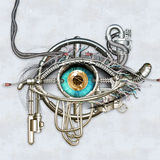Did you remember to exercise your eyes today? I know, I know, I never used to think about my eye health this way either. Like most people that I know, the most attention my eyes usually get is for the obligatory once a year eye exam to get my prescription for contact lenses. I feel like lately, though, everywhere I look (get it?!), I am being confronted with information pointing to the importance of eye health and new ways of viewing eye health (get it?! Okay, sorry done with the puns…). As it turns out, it’s not just about measuring one’s prescription strength for corrective lenses or the absence of disease (e.g., free from glaucoma, cataracts, etc.).
There are certain statements that foreshadow the importance of our eyes beyond just as a special sensory organ. There is a saying, “the eyes are a window to the soul,” and colloquially, we even seem to have this belief or superstition that you can discern someone’s character or intentions by staring into his or her eyes. There are even those people who believe that long durations of eye contact are a crucial part of developing intimacy and human connection (Eye contact with Strangers).
Perhaps a more scientific, although no less grand statement, is along the lines of this quote from Katy Bowman, “Your eyes are a gateway to your brain.”1 There is literature that supports the idea that our eyes, and the visual information that we expose them to, can have a myriad of effects on us as organisms. From a developmental point of view, it has been said that, “what we do with our eyes molds our brains and guides its development—literally. The eyes have the power to turn brain plasticity on or off.”2
As I am learning currently in my neuroanatomy class, the eyes have many functional connections within the brain for both sensory processing and motor control. Out of the twelve cranial nerves that exit the brain and brainstem, five of these nerves have some portion serving the eye (CN’s II, III, IV, V, VI)! The eye is controlled via voluntary muscular control (from the extrinsic eye muscles) and involuntary/autonomic muscular control (ciliary muscles and pupillary sphincter muscles). Eyes really are incredibly important!
Furthermore, the effect of the various types of eye movements that we engage in can have broad systemic effects on our bodily health. As Thomas Myers writes: eye movements can affect the muscles of the head and neck.3 He illustrates this concept via a quick demonstration of how movements at the eye affect the suboccipital muscles (muscles on the back of the neck controlling head/neck position). If you close your eyes, and feel at the base of your skull with your fingers (give a little bit of pressure, the suboccipitals run deep), you can feel these muscles changing tone as you move your eyes side to side and up and down. With this example in mind, it is easier to buy in to Myers’ statement of connectivity of the eyes to other musculature: “How you use your eyes, and more particularly, how you use your neck, determines the tonus pattern for the rest of your back musculature.”3 Also, did you know that people’s visual clarity fluctuates when they are stressed?2
In the prior example, you are engaging in voluntary control of eye movements and positioning. But, the environmental stimuli that you expose your eyes to can also impact eye health due to the intrinsic eye muscles used in reacting to those stimuli. Muscles within your eye itself regulate both the ability to focus at different distances (ciliary muscles) and also the amount of light that enters your eye (pupillary sphincter muscles). Analogous to the way that we use other muscles in our body, without consistent use of certain eye movements (i.e., in distance vision, peripheral vision, night time vision, etc.) we lose the ability to regulate for these different situations. Basically, our eyes get deconditioned and less able to serve the various functions that they were intended to.2,4,5 Your eye muscles can atrophy!1 Once you realize this, it seems all the more important to use your eyes in a variety of settings to help promote good eye health (e.g., looking far away, using your peripheral vision, being in nature!, seeing in pure darkness, seeing in natural light settings).
All of these things have contributed to my newfound intrigue and curiosity about how I use my eyes in my day-to-day life. I hope that something that I have shared has grabbed your attention (…been ‘eye-catching’?!). So, as I think about pursuing a career as a physical therapist and helping others along their journeys of health, one of the questions I will have at the forefront of my mind is: what are you looking at?
References:
- Bowman, K. (2015). Don’t Just Sit There: Transitioning to a Standing and Dynamic Workstation for Whole-Body Health. Elsevier.
- Doidge, N. (2015). The Brain’s Way of Healing: Remarkable Discoveries and Recoveries from Frontiers of Neuroplasticity. New York: Penguin Books.
- Myers, T. (2001). Anatomy Trains: Myofascial Meridians for Manual and Movement Therapists. Elsevier.
- Bowman, K. (2014). Move Your DNA: Restore Your Health Through Natural Movement. Propriometrics Press.
- Katy Says Podcast Episode #45: Natural Movement and Eyes (http://www.stitcher.com/podcast/katy-says/e/42892340?autoplay=true)
